 |
 |

|
Testimony
Wednesday, April 9, 2003Chairman Bilirakis, Mr. Brown, distinguished Subcommittee members, thank you for inviting me to testify today about the financial outlook for the Medicare program as shown in the recently released 2003 annual report of the Medicare Board of Trustees. I welcome the opportunity to assist you in your efforts to ensure the future financial viability of the nation's second largest social insurance program-one that is a critical factor in the income security of the aged and disabled populations. The Trustees Report focuses on the financial status of the Medicare trust funds under current law-that is, whether these funds have sufficient revenues and assets to enable the payment of Medicare benefits and administrative expenses. This analysis compares each trust fund's statutory income, from all sources, to its expenditures and determines whether the fund is operating with a surplus or a deficit in a given year. Most of my testimony is based on this traditional "trust fund perspective." I will also comment briefly on a "budget perspective," that is, the impact of Medicare on the Federal budget. The financial outlook for the Medicare program presents a mixed picture. Over the next 10 years, the Hospital Insurance (HI) and Supplementary Medical Insurance (SMI) trust funds are adequately financed and meet the Trustees' formal tests for short-range financial adequacy. However, HI and SMI expenditures are projected to continue to grow more rapidly than workers' earnings or the economy. HI tax revenues are projected after 2012 to fall increasingly short of program expenditures, eventually covering less than one-third of estimated costs by the end of the Trustees' 75-year projection period. The depletion of the HI trust fund, which had been projected for 2030 in last year's Trustees Report, is now projected to occur in 2026. For SMI, continuing rapid expenditure growth would place growing financial burdens both on beneficiaries and on the Federal budget. The SMI trust fund would remain in financial balance indefinitely, however, due to the annual redetermination of program financing. BackgroundRoughly 41 million people were eligible for Medicare benefits in 2002. HI, or "Part A" of Medicare, provides partial protection against the costs of inpatient hospital services, skilled nursing care, post-institutional home health care, and hospice care. SMI ("Part B") covers most physician services, outpatient hospital care, home health care not covered by HI, and a variety of other medical services such as diagnostic tests, durable medical equipment, and so forth. Only about 22 percent of HI enrollees received some reimbursable covered services during 2002, since hospital stays and related care tend to be infrequent events even for the aged and disabled. In contrast, the vast majority of enrollees incur reimbursable SMI costs because the covered services are more routine and the annual deductible for SMI is only $100. The two parts of Medicare are financed on totally different bases. HI costs are met primarily through a portion of the FICA and SECA payroll taxes(1). Of the total FICA tax rate of 7.65 percent of covered earnings, payable by employees and employers, each, HI receives 1.45 percent. Self-employed workers pay the combined total of 2.90 percent. Following the Omnibus Budget Reconciliation Act of 1993, HI taxes are paid on total earnings in covered employment, without limit. Other HI income includes a portion of the income taxes levied on Social Security benefits, interest income on invested assets, and other minor sources. SMI enrollees pay monthly premiums ($58.70 in 2003) that cover about 25 percent of program costs. The balance is paid by general revenue of the Federal government and a small amount of interest income. The HI tax rate is specified in the Social Security Act and is not scheduled to change at any time in the future under present law. Thus, program financing cannot be modified to match variations in program costs except through new legislation. In contrast, SMI premiums and general revenue payments are reestablished each year to match estimated program costs for the following year. As a result, SMI income automatically matches expenditures without the need for legislative adjustments. Each part of Medicare has its own trust fund, with financial oversight provided by the Board of Trustees. My discussion of Medicare's financial status is based on the actuarial projections contained in the Board's 2003 report to Congress. Such projections are made under three alternative sets of economic and demographic assumptions, to illustrate the uncertainty and possible range of variation of future costs, and cover both a "short range" period (the next 10 years) and a "long range" (the next 75 years). The projections are not intended as firm predictions of future costs, since this is clearly impossible; rather, they illustrate how the Medicare program would operate under a range of conditions that can reasonably be expected to occur. The projections shown in this testimony are based on the Trustees' "intermediate" set of assumptions. Short-range financial outlook for Hospital InsuranceChart 1 shows HI expenditures versus income over the last 10 years and projections through 2012. For most of the program's history, income and expenditures have been very close together, illustrating the pay-as-you-go nature of HI financing. The taxes collected each year are intended to be roughly sufficient to cover that year's costs. Surplus revenues are invested in special Treasury securities. 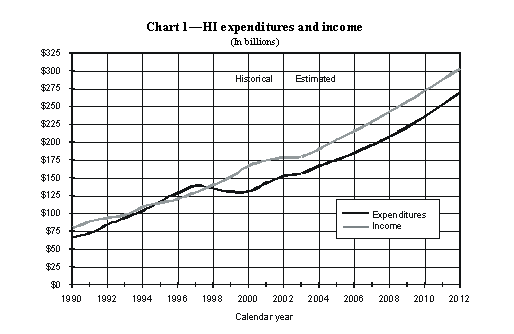 During 1990-97, HI costs increased at a faster rate than HI income. Expenditures exceeded income by a total of $17.2 billion in 1995-97. Prior to the Balanced Budget Act of 1997, this trend was expected to continue, with costs growing at about 8 percent annually, against revenue growth of only 5 to 6 percent. The 1995-97 shortfalls were met by redeeming trust fund assets, but in the absence of corrective legislation, assets would have been depleted in about 2001. The Medicare provisions in the Balanced Budget Act were designed to help address this situation. As indicated in chart 1, these changes-together with subsequent low general and medical inflation and increased efforts to address fraud and abuse in the Medicare program-resulted in lower HI expenditures during 1998-2000 and trust fund surpluses totaling $61.8 billion over this period. The Board of Trustees has recommended maintaining HI assets equal to at least one year's expenditures as a contingency reserve. As indicated in chart 2, HI assets at the beginning of 2003 represented about 150 percent of estimated expenditures for the year. The HI trust fund is estimated to continue to experience significant surpluses for roughly the next 15 years. After 2017, however, expenditures are projected to again exceed income. As shown in chart 2, assets would initially accumulate rapidly but then be drawn down to cover the resulting shortfalls. The trust fund would be exhausted in 2026 under the Trustees' intermediate assumptions. The depletion date estimated in the 2003 Trustees Report represents a significant deterioration compared to last year's estimate (2030). The change arises both from lower projected payroll tax revenues and higher projected inpatient hospital expenditures. The lower payroll taxes are the result of a downward revision by the Bureau of Economic Analysis to their estimates of historical wage and salary disbursements. The higher inpatient hospital cost projections result from more inpatient hospital admissions in 2002 than previously estimated and a greater increase in the average complexity of admissions. Overall, Medicare payments for inpatient hospital care increased by almost 10 percent in 2002-significantly above normal rates of growth. 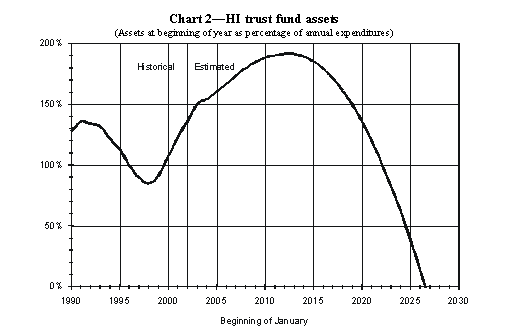 Long-range financial outlook for Hospital InsuranceThe interpretation of dollar amounts is very difficult over extremely long time horizons like the 75-year projection period used in the Trustees Report. For this reason, long-range tax income and expenditures are expressed as a percentage of the total amount of wages and self-employment income subject to the HI payroll tax (referred to as "taxable payroll"). The results are termed the "income rate" and "cost rate," respectively. Projected long-range income and cost rates are shown in chart 3 for the HI program. Past income rates have generally followed program costs closely, rising in a step-wise fashion as the payroll tax rates were adjusted by Congress. Income rate growth in the future is minimal, due to the fixed tax rates specified in current law. Trust fund revenue from the taxation of Social Security benefits increases gradually, because the income thresholds specified in the Internal Revenue Code are not indexed. Over time, an increasing proportion of Social Security beneficiaries will incur income taxes on their benefit payments. 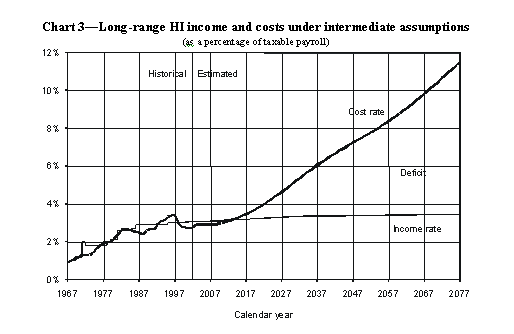 Past HI cost rates have generally increased over time but have periodically declined abruptly as the result of legislation to expand HI coverage to additional categories of workers, raise (or eliminate) the maximum taxable wage base, introduce new payment systems such as the inpatient prospective payment system, etc. Cost rates decreased significantly in 1998-2000 as a result of the Balanced Budget Act provisions together with strong economic growth. The cost rate increased somewhat in 2001 and 2002 as a result of the Benefit Improvement and Protection Act of 2000 and the 2001 economic recession. In general, HI costs are expected to increase faster than taxable payroll, because increases in the prices, utilization, and intensity of health care services collectively exceed increases in workers' earnings. After 2006, cost rates are projected to increase steadily for these reasons and to accelerate significantly with the retirement of the baby boom, beginning in 2010. By the end of the 75-year period, scheduled tax income would cover less than one-third of projected expenditures. The average value of the financing shortfall over the next 75 years-known as the actuarial deficit-is 2.40 percent of taxable payroll. This deficit could be closed by an immediate increase of 1.2 percentage points in the HI payroll tax rate, payable by employees and employers, each. (The projected deficit could also be eliminated by many other revenue increases and/or expenditure reductions.) Note, however, that such a change would correct the deficit only "on average." Initially, HI revenue would be significantly in excess of expenditures, but by the end of the period, only about one-third of the projected deficit would be eliminated. The effect of the baby boom's retirement on Social Security and Medicare is relatively well known, having been discussed at length for nearly 30 years. Basically, by the time the baby boom cohorts have retired, there will be nearly twice as many HI beneficiaries as there are today. When the HI program began, there were 4.5 workers in covered employment for every HI beneficiary. As shown in chart 4, this ratio for 2002 is just under 4.0 workers per beneficiary. With the advent of the baby boom's retirement, the number of beneficiaries will increase more rapidly than the labor force, resulting in a decline in this ratio to 2.4 in 2030 and 2.0 in 2077, based on the intermediate projections. Other things being equal, there would be a corresponding increase in HI costs as a percentage of taxable payroll. 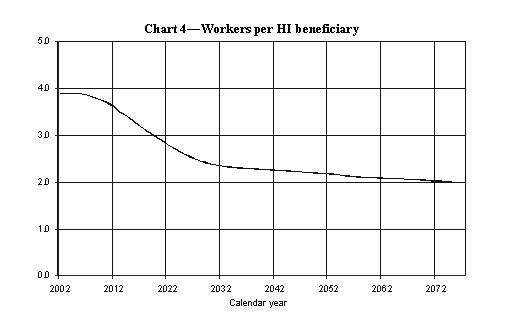 There are other demographic effects beyond those attributable to the varying number of births in past years. In particular, life expectancy has improved substantially in the U.S. over time and is projected to continue doing so. The average remaining life expectancy for 65-year-olds increased from 12.4 years in 1935 to 17.5 years currently, with an estimated further increase to about 22 years at the end of the long-range projection period. Medicare costs are also sensitive to the age distribution of beneficiaries. Older persons incur substantially larger costs for medical care, on average, than younger persons. Thus, as the beneficiary population ages over time they will move into higher-utilization age groups, thereby adding to the financial pressures on the Medicare program. Financial outlook for Supplementary Medical InsuranceChart 5 presents estimates of the short-range outlook for SMI and is generally similar to the information presented in chart 1 for the HI trust fund. Two key differences are evident: First, the income and expenditure curves for SMI are nearly indistinguishable in the future. As noted previously, SMI premiums and general revenue income are reestablished annually to match expected program costs for the following year. Thus, the program will automatically be in financial balance, regardless of future program cost trends. The second difference is that-in contrast to the decline in HI expenditures during 1998-2000-SMI expenditures increased at an average rate of 6.9 percent over this period.  As with HI, the 2002 SMI expenditures were significantly higher than expected, having increased 11.6 percent for the year. Preliminary data indicate that the rapid growth was due in part to (i) the continuing transfer of certain home health services from HI to SMI as specified in the Balanced Budget Act of 1997, (ii) a 7-percent increase in spending on physician services, despite a negative 5.4-percent payment update, (iii) a 20-percent increase in durable medical equipment spending, and (iv) a 25-percent rise in physician-administered drug spending. These cost increases, together with the recent enactment of legislation increasing Medicare payment rates to physicians effective March 1, 2003, will result in an estimated SMI trust fund deficit of $7.4 billion in 2003(2). Program financing for 2004 and later will be established at levels sufficient to cover the higher expenditures. As a consequence, the monthly SMI premium is estimated to increase from $58.70 in 2003 to about $66 in 2004, with general revenue transfers increasing at a correspondingly rapid rate. Chart 6 shows projected long-range SMI expenditures and premium income as a percentage of GDP. Under present law, beneficiary premiums will continue to cover approximately 25 percent of total SMI costs, with the balance drawn from general revenues. In the long run, expenditures are projected to increase at a significantly faster rate than GDP, for largely the same reasons underlying HI cost growth. Although SMI is automatically in financial balance, the program's continuing rapid growth in expenditures places an increasing burden on beneficiaries and the Federal budget. In 2002, for example, about 6.8 percent of a typical 65-year-old's Social Security benefit was withheld to pay the monthly SMI premium of $54.00, and another 8.9 percent was required to cover average deductible and coinsurance expenditures for the year, for a total of 15.7 percent. Twenty years later, under the intermediate assumptions, the same beneficiary's premium and copayment costs would average 23 percent of his or her benefit(3). Similarly, SMI general revenues in fiscal year 2002 were equivalent to 7.8 percent of the personal and corporate Federal income taxes collected in that year. If such taxes remain at their current level, relative to the national economy, then SMI general revenue financing in 2070 would represent 30 percent of total income taxes. 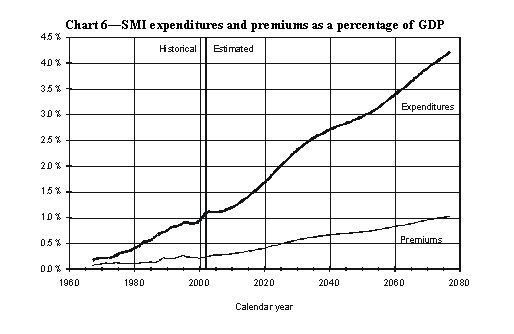 Combined HI and SMI expendituresThe financial status of the Medicare program is appropriately evaluated for each trust fund separately, as summarized in the preceding sections. By law, each fund is a distinct financial entity, and the nature and sources of financing are very different between the two funds. This distinction, however, frequently causes greater attention to the HI trust fund-its projected year of asset depletion in particular-and less attention to SMI, which does not face the prospect of depletion. It is important to consider the total cost of the Medicare program and its overall sources of financing, as shown in chart 7. Interest income is excluded since, under present law, it would not be a significant part of program financing in the long range. Combined HI and SMI expenditures are projected to increase from 2.6 percent of GDP to about 9.3 percent in 2077, based on the Trustees' intermediate set of assumptions. In past years, total income from HI payroll taxes, income taxes on Social Security benefits, HI and SMI beneficiary premiums, and SMI general revenues was very close to total expenditures. Over the next 10 years, such Medicare revenues are estimated to slightly exceed program expenditures, reflecting the automatic financing of SMI plus an expected excess of HI tax income over expenditures. Thereafter, however, overall expenditures are expected to exceed aggregate revenues. Again, the growing difference arises from the projected imbalance between HI tax income and expenditures-since throughout this period, SMI revenues would continue to approximately match SMI expenditures.  Over time, SMI premiums and general revenues would continue to grow rapidly, since they would keep pace with SMI expenditure growth under present law. HI payroll taxes are not projected to increase as a share of GDP, primarily because no further increases in the tax rates are scheduled under present law. Thus, as HI sources of revenue become increasingly inadequate to cover HI costs, SMI premiums and general revenues would represent a growing share of total Medicare income. "Trust fund" versus "budget" perspectivesMedicare's financial operations can be considered from two different viewpoints: a "trust fund perspective" and a "budget perspective." The Trustees Report reflects the perspective of the trust funds, since its purpose is to determine the financial status of these funds by assessing whether they have sufficient revenues and assets to enable the payment of Medicare benefits and administrative expenses. From this trust fund perspective, all types of income are equivalent, and their collective adequacy in covering expenditures is paramount. In particular, the existence of trust fund assets provides the statutory authority to make benefit payments and cover other expenditures. Medicare benefits can be paid if and only if the relevant trust fund has sufficient assets. Congress established the trust fund mechanism for financing Medicare (as well as Social Security and certain other Federal programs) in part for the financial discipline it imposes and also to serve as an early warning if program financing and expenditures fall out of balance. In contrast, the Federal budget focuses on taxes and other amounts received by the government from the public and on amounts paid to the public in the form of benefits, government purchases from the private sector, wages to Federal employees, etc. If aggregate receipts from the public exceed total outlays to the public, then the Federal government has a budget surplus; the opposite relationship results in a Federal budget deficit. In the context of the Federal budget, amounts paid from the general fund of the Treasury to a Federal trust fund, referred to as "intragovernmental transfers," have no impact on the overall budget surplus or deficit and consequently are excluded from consideration. In the budget context, one can look at the public receipts and outlays associated with Medicare and determine the program's impact on the Federal budget-that is, whether Medicare is making a net contribution to the budget or is drawing from the budget. Whether the HI or SMI trust fund is running a surplus or deficit may have little or nothing to do with whether Medicare is contributing to a Federal budget surplus or deficit. Due in part to the similar terminology, however, people have sometimes confused these two different issues. The differences between the trust fund and budget perspectives can be clarified by examining how Medicare revenues are treated under each approach. The following table shows estimated Medicare income by category for 2003 under the Trustees' intermediate assumptions and compares these amounts with expenditures under the two perspectives. 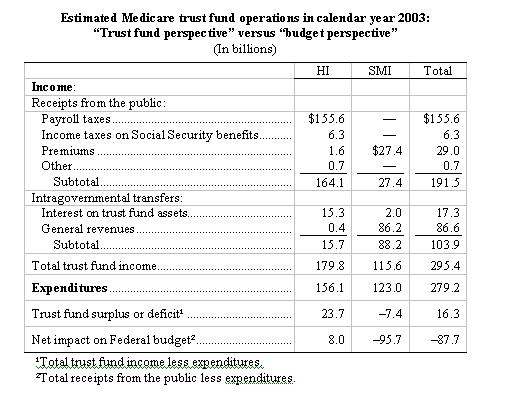 As indicated in the table, all revenue categories are counted for determining trust fund financial status, and the HI trust fund is shown to have an estimated surplus of $23.7 billion in 2003. As noted previously, income from all sources to the SMI trust fund is projected to fall short of expenditures in 2003 by $7.4 billion, requiring the redemption of $7.4 billion in trust fund assets to cover the deficit. From the budget perspective, in contrast, only tax receipts and beneficiary premiums are counted, since interest earnings and general revenue payments represent intragovernmental transfers. HI is projected to have total receipts from the public in 2003 that exceed payments to the public by $8.0 billion. For SMI, the only receipts from the public are the beneficiary premiums, which total $95.7 billion less than SMI expenditures. Accordingly, HI can be thought of as making an estimated net contribution to the Federal budget of $8.0 billion in 2003, while SMI is expected to draw $95.7 billion from the budget. Medicare, overall, is thus projected to draw a net amount of $87.7 billion from the budget. Each viewpoint-the trust fund perspective and the budget perspective-is appropriate for its intended purpose. One point of view cannot be used to answer questions related to the other, however. Trust fund surpluses or deficits reveal nothing about the impact of Medicare on the Federal budget, and the impact of Medicare on the Federal budget offers no insight into whether a trust fund has sufficient assets to permit payment of benefits. ConclusionsIn their 2003 report to Congress, the Board of Trustees emphasizes the continuing financial pressures facing Medicare and urges the nation's policy makers to take further steps to address these concerns. They also argue that consideration of further reforms should occur in the relatively near future. The earlier that solutions are enacted, the more flexible and gradual they can be. In addition, the Trustees note that early action increases the time available for affected individuals and organizations-including health care providers, beneficiaries, and taxpayers-to adjust their expectations. I concur with the Trustees' assessment and pledge the Office of the Actuary's continuing assistance to the joint effort by the Administration and Congress to determine effective solutions to the remaining financial problems facing the Medicare program. I would be happy to answer any questions you might have on Medicare's financial issues.
(1) - Federal Insurance Contributions Act and Self-Employment Contributions Act, respectively. Last Revised: April 21, 2003 |